What has been the situation of boundary disputes across the country in the last 10 years. How has the NBC been able to resolve and ease these disputes?
We have made tremendous progress in the resolution of boundary disputes over the last decade. We must, however, acknowledge that boundary disagreements are inevitable because many people and communities view boundaries from different perspectives. In the case of Nigeria, the situation is very critical as most of our internal boundaries originated from the then colonial powers. The Administrative units were created as Provinces, Divisions and Districts and many were not properly defined and documented. Some of the units have since become States of the Federation with issues of the claims and counter-claims due to non-clarity of the boundaries. While some people perceive boundaries as barriers, others see them more from the traditional perspective rather than administrative demarcations created by the Government.
Administrative boundaries are the creations of government to show limits of jurisdictions. When new States are created, we take into cognizance the existing demarcations of components that transform into the new states. Part of our role is to sensitize people on what boundaries are all about and to show limits. We make them know that being on one side of the boundary does not mean you can no longer own the assets [properties] you may have on the other side. On balance, I will state that in the last 10 years, we have helped reduce the spate of boundary disputes substantially.
Aside from sensitization of the people, what other strategies does the NBC adopt to fulfil its mandate?
The most critical aspect of our mandate is to define the boundaries. The fact is that if a boundary dispute is deemed to have been solved on paper without clearly marking the area, there could be agitations. We have been enthusiastic in marking and demarcating most of the boundaries, though the process has not been as speedy as we would like. We have marked quite a number of the boundaries, especially in the northern parts of the country where there are less boundary disagreements.
We have also made progress on some boundaries in some South-East States [like Enugu and Ebonyi, and Anambra]. We have emplaced some markers to make the boundaries very visible. In the South-West, we have similarly done some work on the Lagos / Ogun as well as Ondo / Oyo inter-states boundaries. Osun / Kwara inter-state boundary has also been demarcated.
We are happy that people are becoming more cautious and co-operative. What matters now is for states to measure up to their expectations, especially when it involves two States; both should try and be ready at the same time for the planned actions aimed at addressing their boundary dispute. If any side is not ready despite our appeals, possibly to frustrate our efforts, we will be compelled to go ahead and sort things out even without the concerned states since we resolve issues mainly on the strength of available documents. Once the documents are ready, any State that gives an excuse of not being ready and wants to frustrate the progress will have itself to blame. It is also pertinent to emphasize here that no individual, Local or State Government, can define any boundary outside what is defined by law as determined by available documents.
What level of collaboration are you getting from other stakeholders and how is the marking process helping to sustain your Commission’s dispute resolution mandate?
Boundary definition, especially physical demarcation, is capital-intensive. We have been doing our best with the available resources as well as the collaboration of our sister agency – the Office of the Surveyor-General. Though inadequate funding has greatly affected the progress in the demarcation but we work in synergy and the NBC or the Surveyor-General of the Federation provide funds for the demarcation work as may be available.
Let me also acknowledge the efforts of the Chairman of the NBC Prof. Yemi Osinbajo SAN and the chairman of the Internal Boundary Committee, His Excellency Babatunde Fashola SAN, through whose intervention funds were made available for the demarcation of the boundaries of the Federal Capital Territory [Abuja FCT] and its neighboring states to address cases of incessant incursions into the FCT. There had been reported cases of encroachment with respect to the FCT/Niger and FCT/Nasarawa boundaries in the past. We may not be moving as fast as expected, but we are making gradual progress.
Given the paucity of funds, how is the Commission coping with its enormous tasks of managing Nigeria’s internal and international boundaries?
The activities of the National Boundary Commission are enormous; hence, the enabling Act provides that we work in synergy with what we call the State Boundary Committees at the State level and the Local Government Boundary Committees at local level. We operate a three-tier boundary management system with the National Boundary Commission at the apex.
We are work hand-in-hand with the State Boundary Committees and the Local Government Boundary Committees. In any case, we expect that things that have to do with inter-community boundary problems within the Local Government Areas [LGAs] will first be handled by Local Government Boundary Committees. If it is a problem between two or more LGAs within a State, it will first be looked into by the State Boundary Committee, while the NBC can concentrate on inter-State disputes. However, the Act provides that we look into all the issues at all tiers — inter-community, inter-LGA, inter-State and at the international level.
These are the bases of our continuous appeals to the State Governments to constitute their State and Local Government Boundary Committees and make them functional and effective. They should be up-and-doing so that these critical issues of boundary disputes would be properly addressed before they escalate to a level that we have to be involved.
As I indicated earlier, our activities are many. We are not only looking at boundary dispute resolution, but also at trans-border activities; trying to promote harmonious cooperation among our communities, educating people to understand what borders are.
We organize seminars and workshops to get people to buy into the concept of boundaries. Boundaries are for administrative convenience and intended to show limits. Boundaries should not be seen as barriers between communities that have co-existed for long; and because of that we do organize some sensitization fora from time to time to let people appreciate the concept of boundaries. Though it is never enough, I dare say that funding has improved significantly since the coming of the current administration. You see, we are really making some progress.
Since your coming on board as the Commission’s DG, I believe you have some targets and strategies to achieve the Agency’s mandate, can you shed light on them
My main targets are to get as many of these boundary problems sorted out as quickly as possible and to commence gradual demarcation of those boundaries We are making progress because with the improvement in funding we have commenced activities on the demarcations.
Incidentally, this year is an election year and as such many of the States are not forth-coming in terms of readiness for some of our planned activities as expected. There are occasional delays but we are meeting our targets because this year we have outlined what we intend to do based on the financial provisions we have on the budget. When the State Boundary Committees are properly constituted and meet often, we can begin to jointly articulate some of these issues and address them more adequately. At times, I have to bring in some of our past colleagues to work with us on boundary issues and they have been very useful and cooperative.
I thank God that in my two and a half years on the seat so far, I have been able to cope with the challenges, taking advantage especially as I have been part and parcel of the system for quite some time before my appointment.
Is there any aspect of the Act establishing your Commission that you think should be reviewed to effectively tackle boundary disputes?
I do not think so. My main plea is to State Governments for more cooperation in the fulfillment of our collective mandate as stipulated by the enabling law. People are beginning to be aware and appreciate boundaries. But If anyone proves hard, the federal government will wade in as the law is sufficient to handle every matter.
Of course, there is a need for adequate funding from the Federal Government and for the State Governments to invest in boundary management as it affects their jurisdictions. We solicit the cooperation and support of all stakeholders in our quest to define and demarcate all interstate boundaries. It is a fact that a boundary can only effectively serve its purpose and function if it can be identifiable on ground and recognized by the communities it is to serve.











